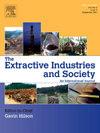制定通过尾矿矿物碳化固碳的核查框架:澳大利亚情况
IF 4.3
2区 社会学
Q2 ENVIRONMENTAL STUDIES
Extractive Industries and Society-An International Journal
Pub Date : 2025-06-03
DOI:10.1016/j.exis.2025.101696
引用次数: 0
摘要
矿物碳酸化的加速使澳大利亚的采矿业能够利用富含钙、镁和铁的硅酸盐废物,通过化学方法永久储存大气中的二氧化碳,并在国际碳市场上出售这些排放物。十多年来,碳抵消信用额度一直保持着一个现成的市场。但是,对于核查碳抵消信用额,特别是那些来自矿山废物和尾矿矿物碳化的碳抵消信用额,存在争论。本文介绍了一种新的方法,矿物碳化如何在排放交易计划中发挥作用。在清洁发展机制和联合执行下为矿物碳酸化项目定性确定关键核查参数的现有核定农林业方法之间存在相似之处。本文还讨论了未来十年及以后碳市场供需双方的潜在增长,以评估在全球范围内引入矿物碳酸化的影响。欧洲碳市场和NordPool的市场变动证明了市场波动性的降低,国际碳市场的持续扩张也反映了这一点。本文章由计算机程序翻译,如有差异,请以英文原文为准。
Developing a verification framework for carbon sequestration through mineral carbonation of mine tailings: An Australian context
Accelerated mineral carbonation enables the Australian mining industry to capitalize on Ca-, Mg-, and Fe-rich silicate wastes by chemically storing atmospheric carbon dioxide permanently and selling these emissions removals on the international carbon market. Carbon offset credits have maintained a ready market for over a decade. However, there is debate regarding the verification of carbon offset credits, particularly those derived from the mineral carbonation of mine waste and tailings. This paper introduces a novel approach to how mineral carbonation could function within an Emissions Trading Scheme. Similarities are drawn between existing approved methodologies in agroforestry to qualitatively establish key verification parameters for mineral carbonation projects under the Clean Development Mechanism and Joint Implementation. This paper also discusses the potential growth on both the supply and demand sides of the carbon market over the coming decade and beyond to assess the impact of introducing mineral carbonation globally. Examples of market movements in the European carbon market and NordPool provide evidence of reduced market volatility, with the continued expansion mirrored by the international carbon market.
求助全文
通过发布文献求助,成功后即可免费获取论文全文。
去求助
来源期刊

Extractive Industries and Society-An International Journal
ENVIRONMENTAL STUDIES-
CiteScore
6.60
自引率
19.40%
发文量
135
 求助内容:
求助内容: 应助结果提醒方式:
应助结果提醒方式:


